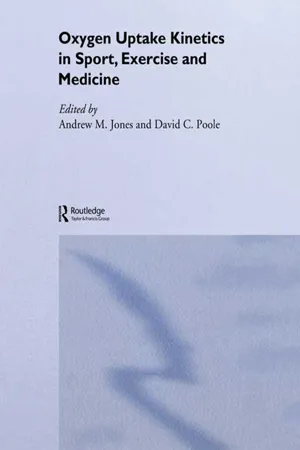![]()
Part I
Introduction
![]()
1 Introduction to oxygen uptake kinetics and historical development of the discipline
Andrew M. Jones and David C. Poole
A brief note on the history of oxygen and modern man
Today, we live in an atmosphere that contains 20.9% oxygen (O2). In contrast, when the solar system was created approximately 4.6 billion years ago (Dickerson, 1978), the atmosphere of the Earth was completely devoid of both O2 and ozone (O3). In the absence of a protective high-altitude O3 layer, the sun’s ultraviolet radiation bombarded the surface of the earth. This radiation synthesized organic compounds (amino acids) from water, carbon dioxide (CO2), methane, hydrogen and ammonia – the so-called ‘primordial soup’ that generated the first self-replicating chains of molecules. Fossils dating back over 3.5 billion years provide evidence of synthetic processes that enabled living organisms to capture solar energy and fabricate organic molecules such as glucose. Anaerobic fermentation (glycolysis) which powered these creatures may well have preceded all other biological energy-extracting pathways found on Earth. These ancient organisms released O2 into the atmosphere and over the next two billion years an atmosphere was created where over one out of five molecules was O2. In Shark Bay, Western Australia these algae-like micro-organisms known as cyanobacteria still cluster ~3 billion or so to the square metre in colonies on formations called stromalites. On close observation small streams of bubbles – molecular oxygen – can be seen rising from the stromalites. It is somewhat ironic that these cyanobacteria instigated life on Earth only to be eaten almost out of existence by their progeny.
Two of the most important effects of this O2 atmosphere were as follows: (1) The formation of an O3 layer in the upper atmosphere which effectively diminished the ultraviolet radiation reaching the Earth’s surface. This halted non-biologic synthesis of organic matter. (2) O2 may have reached toxic levels for many of the original O2 producers and new metabolic pathways developed that utilized O2 as a hydrogen acceptor. Solar energy in the visible wavelengths still reached the Earth and supported biologic photosynthesis.
The earliest and most simple form of aerobic life appeared about 1.5 billion years ago. This unicellular organism was eukaryotic (i.e. had a nucleus) and performed some of the fundamental functions that characterize cellular activity today, that is metabolism, excitability, locomotion and reproduction (Vidal, 1984). These organisms possessed DNA-containing mitochondria and from this point on, these mitochondria would be present in nearly all forms of life on Earth (Dickerson, 1980a,b; Astrand and Rodahl, 1986). Today, the storage and exchange of energy necessary to power these functions in most living organisms relies principally upon adenosine triphosphate (ATP). Energy is released when ATP is hydrolysed by water into adenosine diphosphate (ADP) and phosphate ion. Intracellular ATP stores are very limited, in part, because ATP is extremely heavy. For example, an active person could easily expend his/her own body weight in ATP each day. To sustain cellular function and integrity, it is crucial that ATP concentrations are maintained within very tight limits and hence, phosphocreatine (PCr) stores which are typically several fold higher than those of ATP, fall in response to increased energetic demands and in so doing, regenerate and stabilize ATP concentrations. The contraction-induced perturbation of the intracellular milieu (↓PCr, ↑Cr, ↑ADPfree, ↑inorganic phosphate, ↑calcium) and accelerated glycolytic activity stimulate mitochondrial (aerobic) ATP resynthesis and enable the transition to greater metabolic rates that can be sustained for prolonged periods, providing that the commensurate supply of O2 and substrates and the removal of heat and metabolic waste is achieved.
One major limit to increasing body size is the problem imposed by O2 and substrate diffusion. This is effective over distances of microns but not millimetres or more. Beginning about 700 million years ago, larger animals began to develop (Valentine, 1978); but they could do so only after the O2 diffusion problem had been surmounted. This was achieved by retaining a relatively small individual cellular mass, piling many of these cells together and developing cells dedicated to a particular function. Within the human body there are over 200 different cell types and specialized structures, the genes, provide a hierarchical control over cellular proliferation, structure and function.
As individual cells lost intimate contact with the external environment, transporti...
